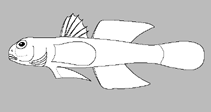Upload your photos and videos
Google imageNo image available for this species;
drawing shows typical species in Gobiidae.
Google imageNo image available for this species;
drawing shows typical species in Gobiidae.
Classification / Names Common names | Synonyms | Catalog of Fishes(genus, species) | ITIS | CoL | WoRMS | Cloffa
Teleostei (teleosts) > Gobiiformes (Gobies) > Gobiidae (Gobies) > Gobiinae
Etymology: ingressus: Name from Latin word which means enter, step or go into, referrring to the species’ entering the Mediterranean (Lessepsian migrant).
Etymology: ingressus: Name from Latin word which means enter, step or go into, referrring to the species’ entering the Mediterranean (Lessepsian migrant).
Environment: milieu / climate zone / depth range / distribution range Ecology
Marine; benthopelagic; depth range 5 - 20 m (Ref. 119377), usually 7 - 15 m (Ref. 119377). Subtropical
Distribution Countries | FAO areas | Ecosystems | Occurrences | Point map | Introductions | Faunafri
Mediterranean Sea. Lessepsian migrant.
Size / Weight / Age
Maturity: Lm ? range ? - ? cm
Max length : 2.5 cm SL male/unsexed; (Ref. 119377); 3.2 cm SL (female)
Max length : 2.5 cm SL male/unsexed; (Ref. 119377); 3.2 cm SL (female)
Short description Identification keys | Morphology | Morphometrics
Dorsal spines (total): 7; Dorsal soft rays (total): 8; Anal spines: 1; Anal soft rays: 8. This species is distinguished by the following characters: absence of a black spot/blotch at rear of first dorsal fin; D2 I,8; A I,8-9; pectoral fin rays 17-18; scales in lateral series 25-28; predorsal scales ctenoid 6-7; gill rakers short and stout 2+8; suborbital rows of sensory papillae with rows a and c in reduced and disorganised transverse pattern (Ref. 119377).
This species was observed in vegetated [Lessepsian seagrass Halophila stipulacea (Forsskål) Ascherson, 1867] soft bottom and sloping habitats and also prefers areas where the water movement is limited, such as in sheltered bays. Populations were observed at 5-20 m depth but were more abundant at 7-15 m depth with approximately 1-3 individuals per sq.m (Ref. 119377).
Life cycle and mating behavior Maturity | Reproduction | Spawning | Eggs | Fecundity | Larvae
Main reference
Upload your references | References | Coordinator | Collaborators
Engin, S., H. Larson and E. Irmak, 2018. Hazeus ingressus sp. nov. a new goby species (Perciformes: Gobiidae) and a new invasion in the Mediterranean Sea. Mediterranean Marine Science 19(2):316-325. (Ref. 119377)
CITES
Not Evaluated
Threat to humans
Harmless
Human uses
Fisheries: of no interest
FAO - Publication: search | FishSource |
More information
Trophic ecology
Food items
Diet composition
Food consumption
Food rations
Predators
Food items
Diet composition
Food consumption
Food rations
Predators
Ecology
Ecology
Ecology
Population dynamics
Growth parameters
Max. ages / sizes
Length-weight rel.
Length-length rel.
Length-frequencies
Mass conversion
Recruitment
Abundance
Growth parameters
Max. ages / sizes
Length-weight rel.
Length-length rel.
Length-frequencies
Mass conversion
Recruitment
Abundance
Life cycle
Reproduction
Maturity
Maturity/Gills rel.
Fecundity
Spawning
Spawning aggregations
Eggs
Egg development
Larvae
Larval dynamics
Reproduction
Maturity
Maturity/Gills rel.
Fecundity
Spawning
Spawning aggregations
Eggs
Egg development
Larvae
Larval dynamics
Anatomy
Gill area
Brain
Otolith
Gill area
Brain
Otolith
Physiology
Body composition
Nutrients
Oxygen consumption
Swimming type
Swimming speed
Visual pigments
Fish sound
Diseases & Parasites
Toxicity (LC50s)
Body composition
Nutrients
Oxygen consumption
Swimming type
Swimming speed
Visual pigments
Fish sound
Diseases & Parasites
Toxicity (LC50s)
Genetics
Genetics
Heterozygosity
Heritability
Genetics
Heterozygosity
Heritability
Human related
Aquaculture systems
Aquaculture profiles
Strains
Ciguatera cases
Stamps, coins, misc.
Aquaculture systems
Aquaculture profiles
Strains
Ciguatera cases
Stamps, coins, misc.
Tools
E-book | Field guide | Length-frequency wizard | Life-history tool | Point map | Classification Tree
| Catch-MSY |
Special reports
Download XML
Internet sources
AFORO (otoliths) | Aquatic Commons | BHL | Cloffa | BOLDSystems | Websites from users | Check FishWatcher | CISTI | Catalog of Fishes: genus, species | DiscoverLife | ECOTOX | FAO - Publication: search | Faunafri | Fishipedia | Fishtrace | GenBank: genome, nucleotide | GloBI | Google Books | Google Scholar | Google | IGFA World Record | MitoFish | National databases | Otolith Atlas of Taiwan Fishes | PubMed | Reef Life Survey | Socotra Atlas | Tree of Life | Wikipedia: Go, Search | World Records Freshwater Fishing | Zoobank | Zoological Record
Estimates based on models
Phylogenetic diversity index (Ref. 82804): PD50 = No PD50 data [Uniqueness, from 0.5 = low to 2.0 = high].
Bayesian length-weight: a=0.00724 (0.00339 - 0.01546), b=3.10 (2.92 - 3.28), in cm total length, based on LWR estimates for this (Sub)family-body shape (Ref. 93245).
Trophic level (Ref. 69278): 3.1 ±0.3 se; based on size and trophs of closest relatives
Resilience (Ref. 120179): High, minimum population doubling time less than 15 months (Preliminary K or Fecundity.).
Fishing Vulnerability (Ref. 59153): Low vulnerability (10 of 100).




